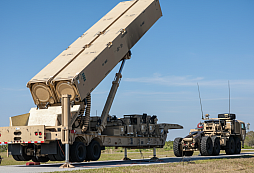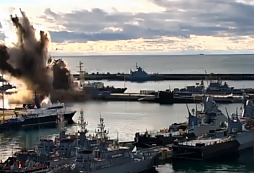Special crisis training: Active reserves and professionals tested in a real-conflict simulation
Members of the Special Forces (SF) and their Active Reserves, represented by the Special Forces Directorate and, in particular, the Special Forces Support Center (CPSS), underwent unique seven-day special training at the Březina military training area near Vyškov. The aim of the program was to prepare participants for operations in environments with elements of armed conflict, develop their ability to respond under psychological and physical pressure, and acquire the key skills needed to function in the field.

The special training included not only theoretical preparation covering the basics of military procedures, orientation in crisis deployment environments, and stress management psychology, but above all practical exercises. Participants had to cope with sleep deprivation, limited energy intake, pressure situations, and simulated interrogations. "I am glad that this event, which focuses on crisis situations, took place. It is traditionally organized by the Military Academy in Vyškov, which has many years of experience in this field. But what is unique about this run is our involvement—the special forces, specifically the Special Forces Support Center," said Brigadier General Miroslav Hofírek, Director of the Ministry of Defense's Special Forces Directorate. "We managed to adapt the special training to the methods used by special forces, and as a result, an event was created that had never been held in this format before," he added.
The fictional environment of Montawy
The exercise was based on a model situation in the fictional country of Montawa, which is struggling with ethnic tensions and separatism in the Tugurska region. Participants found themselves in an environment where they had to negotiate with civilians, face protests and attacks on their base, and deal with evacuation. "Our goal is to bring participants as close to reality as possible, so we simulate an environment in which various entities operate—from local villagers to armed forces to international observers. Although they are soldiers, we put participants in the roles of unarmed personnel who must survive in an environment of armed conflict. Their only weapons are their brains, common sense, and communication skills," added Captain Vašina, the special training supervisor.

Practical part and hybrid threats
The program included survival in nature, improvised shelter construction, food preparation from limited resources, movement in a demilitarized zone, and escape and concealment from the enemy. The culmination was a high-pressure exercise involving capture and interrogation, during which participants tested their limits.
"We want soldiers to experience a crisis situation in a safe environment, but as realistically as possible. That means psychological pressure, discomfort, and the need to improvise. Only then can we achieve a real shift in preparedness," added Capt. Vašina.
"It was very intense. You realize that even if you have undergone classic training, the pressure of insomnia and uncertainty takes its toll. It taught us a lot about working together and not losing our heads," said one of the participants from the Active Reserve.

Cooperation between units
In addition to special forces, the Military Academy in Vyškov, KVV Brno and KVV Ostrava, the 102nd Reconnaissance Battalion, the 22nd Helicopter Aviation Base with the SOATU unit, the 533rd Unmanned Systems Battalion, the 91st Information Warfare Group, the University of Defense, dog handlers from SDAT K9, the Czech Police, and the Prison Service.
"This special preparation clearly showed that expertise alone is no longer enough. We need to combine different capabilities—military, security, and civilian. Only then can we respond to today's complex challenges," emphasized Brigadier General Miroslav Hofírek. At the same time, he also praised the CPSS approach: "What the CPSS has brought is the ability to model scenarios based on current threats. As a result, this is no longer traditional training, but a program that reflects today's hybrid environment."
"It is also important to confirm the need and ability to connect soldiers, reservists, the police, the prison service, and the academic sphere. Only this breadth creates the resilience of the state," added General Hofírek. Thanks to the active approach and commitment of all participating units and institutions, this unique special training was successfully implemented in such a comprehensive form.
Rescue operations and the role of PR-Cell
The backbone of the scenario consisted of rescue operations carried out by special forces, which in some cases, with the support of local units, extracted isolated individuals. Their activities were followed up by PR-Cell SF, led by Staff Sergeant Jan Š., a PR and SERE SF instructor and evaluator, who was responsible for planning rescue operations, identifying risks, coordinating actions, and communicating with support units.
Special training covered all key PR (Personnel Recovery) modalities:
- CSAR (Combat Search and Rescue) – combat search and rescue in an environment with enemy presence
- NAR (Non-conventional Assisted Recovery) – non-conventional assisted recovery
HRO (Hostage Rescue Operation) – hostage rescue - UAR (Unassisted Recovery) – recovery carried out independently by the isolated person.
PR-Cell (Personnel Recovery Cell) is a specialized team coordinating the rescue of isolated personnel (ISOP) within special forces. It acts as a coordinating element between command, rescue teams, intelligence support, and other support assets. It manages operations in real time using ISR, QRF, and other available capabilities, creating the backbone for the successful execution of the entire operation. Thanks to centralized control and the interconnection of all components, it significantly reduces the risk of mission failure, loss of life, and unwanted escalation of the situation, and increases the chance of a safe return of the isolated person and the protection of the rescue units.
The authenticity of this event was enhanced by a combination of various resources: ScanEagle and Puma UAVs, as well as helicopters from the 22nd Helicopter Air Base’s SOATU unit, K9 dog handlers, with the support of deployed HUMINT teams from the 102nd Reconnaissance Battalion and simulated media from the 91st Information Warfare Group. Each action was followed by a debriefing with an analysis focused on psychological stabilization and reflection on the experience.

"For us instructors, it was important to keep the special training realistic, but also safe. We were looking for the limit where pressure would force participants to improvise and make decisions. We tried to bring them to the imaginary limit of their abilities so that they would have the opportunity to surpass themselves—without endangering their health," explained Staff Sergeant Jan Š.

Debriefing and reintegration
More than 190 people from sixteen entities participated in the special training. The program ran continuously for seven days. However, after the successful rescue, the work for PR-Cell was not over – the team, together with intelligence officers, SERE specialists, and psychologists, conducted a detailed intelligence debriefing and two phases of reintegration. This joint approach not only enabled a quick and non-duplicative evaluation of the experience, but also, thanks to the Special Forces members, reduced the risk of retraumatization of the isolated person (ISOP) and contributed to the psychological stabilization of the trainees.
The concept also includes a support system for the family of the rescued person. PR-Cell, together with specialists, provides family members with information about the situation, security and legal consultations, and, above all, psychological and medical support. The aim is to protect not only the isolated person after their return, but also to provide support to their family, which is under considerable strain during the crisis.
"We are able to provide this service not only to SF members, but also to other units whose members have been through a crisis situation and need professional support," added Staff Sergeant Jan Š. "Special training does not end when a soldier returns from action. Their mental stability and ability to integrate their experiences back into service and life are also important. This program has shown that we must also emphasize this dimension," added General Hofírek.
Conclusion
After the special training was completed, an evaluation and feedback from all involved units and participants themselves followed. The knowledge gained will be used to further improve the methodology and gradually expand the model to other units of the Czech Armed Forces.
The special training not only expanded the professional knowledge and practical skills of professional soldiers and active reserves, but also strengthened their resilience, teamwork, and ability to function in an environment where there are no easy answers. At the same time, it confirmed that the interconnection of military, security, and civilian units is a key prerequisite for an effective response to current crisis threats.
Further development of this concept is expected in the future, with greater involvement of civilian experts, expansion of scenarios to include new types of hybrid threats, and transfer of experience to the area of preparation of selected elements of the Integrated Rescue System. Rescue operations and knowledge of their processes are also an integral part of preparing for foreign deployments – because it is precisely in an emergency, when things go wrong, that determination, readiness, and the ability to improvise are decisive.

Special preparation can thus become a stable element that not only increases operational readiness, but also strengthens society’s overall resilience to crisis situations.
























